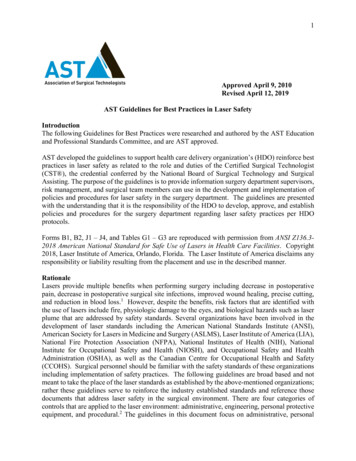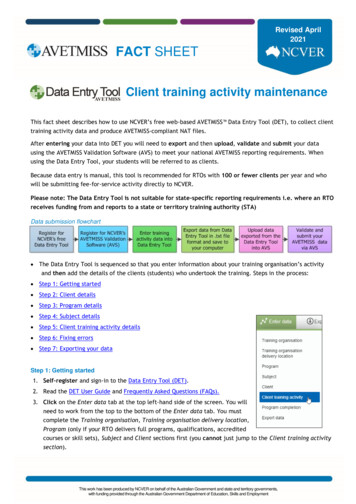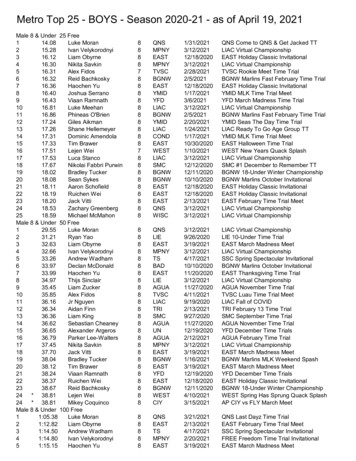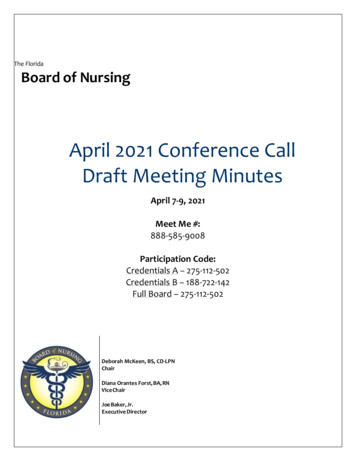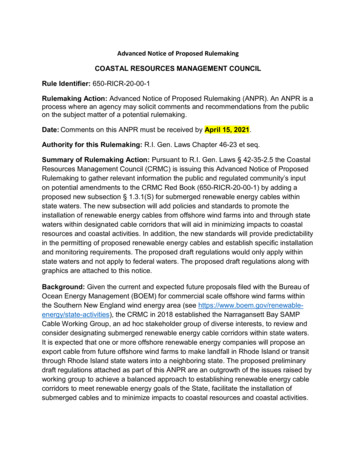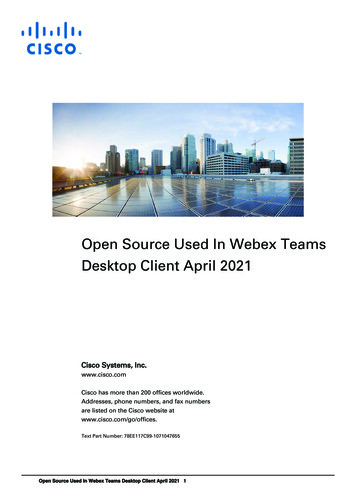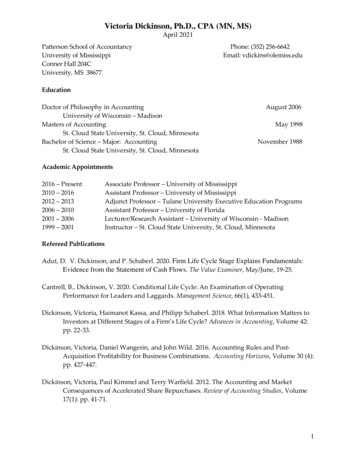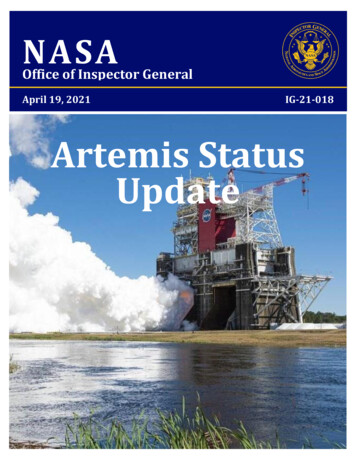
Transcription
NASAOffice of Inspector GeneralApril 19, 2021IG-21-018Artemis StatusUpdate
Office of Inspector GeneralTo report, fraud, waste, abuse, or mismanagement, contact the NASA OIG Hotline at 800-424-9183 or 800-535-8134 (TDD) orvisit https://oig.nasa.gov/hotline.html. You can also write to NASA Inspector General, P.O. Box 23089, L’Enfant Plaza Station,Washington, D.C. 20026. The identity of each writer and caller can be kept confidential, upon request, to the extent permittedby law.To suggest ideas or request future audits, contact the Assistant Inspector General for Audits at https://oig.nasa.gov/aboutAll.html.
INTRODUCTIONNASA’s current plans for the first three missions of its Artemis program include exploration missions toorbit the Moon in 2021 (uncrewed) and 2023 (crewed) using the Space Launch System (SLS) rocket andOrion Multi-Purpose Crew Vehicle (Orion), culminating in a mission landing astronauts on the surface ofthe Moon in late 2024 (see Figure 1). With total costs for Artemis missions through fiscal year (FY) 2025projected to reach 86 billion, NASA’s development of a deep-space human exploration capability toreach the Moon as a precursor to Mars is the Agency’s most ambitious and costliest ongoing activity.Figure 1: Artemis Missions Through Planned Moon LandingSource: NASA Office of Inspector General (OIG) presentation of Agency information.While NASA had been working for the past decade to return astronauts to the Moon, in March 2019the White House directed the Agency to accelerate its timetable by approximately 4 years in order toland on the Moon by the end of 2024. Although the new Administration has expressed support ofthe Artemis program, it has not spoken in any detail about its human exploration plans or its intent tomaintain the goal of a 2024 lunar landing.As NASA moves forward, it will be critical for the Agency to address a number of challenges to successfullymeet Artemis-related mission and program milestones.1 This includes providing transparent reportingand calculation of program costs, realistic schedules, and clearly defined system requirements; solidifyinginternational partnerships; and balancing the use of commercial space capabilities with traditionalacquisition approaches. Over the past decade, our oversight work has found that NASA consistentlystruggles to address these significant issues, each of which will likely be further exacerbated by thecurrent timetable for Artemis missions I through III. Adding to these issues in the near term are thechallenges associated with the coronavirus disease 2019 (COVID-19) pandemic, a change in presidentialadministration, and FY 2021 funding for the Human Landing System (HLS) ( 850 million) that wasapproximately 75 percent less than requested in the FY 2021 President’s budget request ( 3.4 billion).This report provides a status update on the Agency’s progress on achieving milestones for the majorprograms that support Artemis. This high-level synopsis largely draws from and updates our recentaudit work on the Artemis program. Although we make no formal recommendations in this report,we continue to monitor the Agency’s efforts towards achieving a lunar landing and its follow-on plans1NASA, Artemis Plan: NASA’s Lunar Exploration Program Overview (September 2020) describes the Agency’s Moon to Marsexploration approach.NASA Office of Inspector GeneralIG-21-018 1
to send a crewed mission to Mars in the 2030s. See Appendix B for a summary of openrecommendations made in our previous reviews of the major programs that support Artemis.BackgroundNASA’s Human Exploration and Operations Mission Directorate (HEOMD) manages the activities of thetwo organizations responsible for developing Artemis systems: Exploration Systems Development (ESD)is responsible for SLS, Orion, Exploration Ground Systems (EGS), and the Artemis I and II missions; andAdvanced Exploration Systems (AES) is in charge of the Gateway and HLS programs, other explorationresearch and development offices, and Artemis III and additional Artemis missions. In 2020, the Agencyfurther clarified its lunar ambitions with publication of the Artemis Plan and established—and iscontinuing to stand up—a Systems Engineering and Integration Office at the HEOMD-level to definerequirements and exploration architectures to integrate systems and activities across the missiondirectorate.2 In total, NASA has spent 37.2 billion to date on Artemis-related program activities.Figure 2 presents a cost breakdown for NASA’s Artemis missions by program.3Figure 2: Artemis Mission Programs (as of March 2021)Source: NASA OIG presentation of Agency data.Amounts are rounded. Total overall funding may not equal the sum of the rounded amounts.aExploration research and development fund other areas such as development of exploration and lunar systems and humanresearch programs.2NASA’s Artemis Plan outlines the programs and plans for its Artemis missions—aimed at setting a sustainable course to theMoon, landing humans on the Moon in 2024, and extending lunar missions and preparing for Mars. NASA HEOMD’s SystemsEngineering and Integration Office is responsible for translating the Agency’s human space exploration vision into anintegrated portfolio by defining actionable program objectives and requirements for HEOMD organizations to implement.3The program calculations include HEOMD costs only (beginning in FY 2012) and do not include Artemis-related projectsunder NASA’s Science Mission Directorate such as the Lunar Discovery and Exploration Program that manages lunar surfacepayload deliveries, develops technology for lunar science, and conducts lunar mapping in support of the Artemis missions.Science Mission Directorate costs related to Artemis are being examined in our ongoing audit project A-20-008-01 on NASA’sArtemis missions.NASA Office of Inspector GeneralIG-21-018 2
ARTEMIS ELEMENTS ENTERING CRITICAL PHASEAs the Agency works toward meeting an Artemis I launch date of November 2021, NASA must addressa series of critical issues with Artemis hardware and software components as they prepare the disparatesystems for integration. Successfully addressing these outstanding issues while ensuring adequate costcontrol and schedule margin will be critical to the success of the Artemis program over its next phase ofdevelopment and integration.Second Green Run Hot Fire Test of SLS CompletedThe SLS is being built to meet the Agency’s long-term human exploration goal of landinghumans on Mars.4 The first three Artemis missions will use the SLS’s Block 1 configurationconsisting of a core stage with four RS-25 engines, two solid rocket boosters, and the upperstage including an Interim Cryogenic Propulsion Stage (ICPS).5 For Artemis IV and beyond,NASA plans to use SLS’s Block 1B configuration, which swaps out the ICPS and replaces it with a morepowerful Exploration Upper Stage (EUS) consisting of larger fuel tanks and four RL-10 engines. By theend of FY 2020, NASA had spent more than 17 billion on the SLS—NASA’s “critical path” for theArtemis missions—and is projected to spend an additional 11.3 billion through FY 2025.6As we previously reported, each of the major contracts for developing the SLS for Artemis I hasexperienced technical challenges, performance issues, and requirement changes that have resultedin 2 billion of overall cost increases and at least 2 years of schedule delays.7 After months ofpreparation and delays, in January 2021 NASA performed the hot fire test—the last of its Green Runtests—on the SLS core stage’s four RS-25 engines to ensure the rocket was ready for the first Artemismission.8 However, NASA’s testing software prematurely ended the planned 8-minute test after67 seconds to reduce the risk of damaging the core stage. A “redo” of the hot fire test planned forlate February 2021 was postponed to address an issue with a valve supplying liquid oxygen to one ofthe RS-25 engines. In March 2021 the Agency conducted the second hot fire test and in April 2021completed its analysis of over 8 minutes’ worth of data and found all primary test objectives were met.The SLS core stage is now being prepared for transport to Kennedy Space Center (Kennedy) in Florida.Delays in completing a successful hot fire test places further pressure on NASA’s planned schedule tolaunch Artemis I in 2021 because EGS’s integration of the SLS, Orion, and associated ground hardware4Congress directed NASA to use the SLS rocket through the National Aeronautics and Space Administration Authorization Actof 2010, Pub. L. No. 111-267, 124 Stat. 2805 (2010).5The ICPS will serve as the second stage for the first three Artemis launches. Based upon a similar design used on the Delta IVHeavy rocket, the ICPS is a liquid-oxygen and liquid-hydrogen system with a single RL-10 engine.6FY 2025 figure based on the FY 2021 President’s budget request. The critical path refers to the sequential path of tasks in anetwork schedule that represents the longest overall duration from “time now” or presently through project completion.Any slippage of the tasks in the critical path will increase the project’s duration.7NASA OIG, NASA’s Management of Space Launch System Program Costs and Contracts (IG-20-012, March 10, 2020).8The Green Run is a series of eight tests on the core stage flight hardware for the SLS, with the hot fire test ending the series.These tests verify the stage is ready for the first and future Artemis missions.NASA Office of Inspector GeneralIG-21-018 3
takes approximately 10 months from delivery of the SLS core stage to Kennedy from its testing site atStennis Space Center in Mississippi. Moreover, delays to the Artemis I launch will impact the schedulefor future Artemis missions.9 At the same time, the COVID-19 pandemic has challenged the timetablefor Artemis II, reducing schedule margins for manufacturing the SLS core stage and Launch Vehicle StageAdapter by an estimated 3 months and increasing projected development costs by 363 million as of theend of FY 2020.10 For Artemis III, although the definitization of NASA’s contract with The BoeingCompany—scheduled for March 2021—has still not been completed, core manufacturing is ongoing.11Despite these delays, the SLS has continued to make progress. In December 2020, NASA completed itsCritical Design Review for the EUS.12 In addition, the Europa Clipper mission was initially set to launch in2023 using an SLS, potentially causing schedule delays for Artemis missions due to the lack of availableSLS vehicles. However, NASA is exploring flexibilities provided in the Agency’s FY 2021 appropriations tosolicit for a commercial launch vehicle for the Clipper, a result that would ensure a more stable manifestfor future Artemis missions.13 To learn more about the NASA Office of Inspector General’s (OIG) auditwork of the SLS Program, see NASA’s Management of the Space Launch System Stages Contract andNASA’s Management of Space Launch System Program Costs and Contracts.Orion Elements in Final Integration and Testing atLaunch SiteOrion serves as NASA’s exploration vehicle for the Artemis missions to carry crew beyond lowEarth orbit; sustain and support up to four astronauts during in-space operations; and providereentry, descent, and landing back to Earth. Orion is composed of the Launch Abort System,Crew Module, Service Module, and the Spacecraft Adapter connecting Orion to the SLS.In January 2021, Orion was transferred to the EGS Program for integration with the SLS and associatedground equipment at Kennedy. Six months earlier, we reported that the Orion Program has experiencedover 900 million in cost growth through 2019, a figure expected to rise to at least 1.4 billion through2023.14 In the same timeframe, the Program’s schedule for Artemis I slipped 3 years while the schedulefor Artemis II slipped 2 years with additional delays likely as Orion completes development efforts for9Government Accountability Office, NASA Human Space Exploration: Significant Investments in Future Capabilities RequireStrengthened Management Oversight (GAO-21-105, December 15, 2020), and NASA program documentation. The Agencyrequires 20 months to complete launch preparation activities between the first and second Artemis missions.10Impacts from COVID-19 increased cost projections for FY 2020 by 8 million and by 355 million in future years.11To “definitize” a contract is to write the specific requirements of a program or project into the contract. NASA policygenerally requires definitization of contracts within 6 months of an undefinitized contract action.12Critical Design Review is the life-cycle review in which the decision authority evaluates the integrity of the project’s designand its ability to meet mission requirements with appropriate cost and schedule margins and acceptable risk within definedproject constraints, including available resources. This review also determines if the design is appropriately mature tocontinue into the final design and fabrication phase.13The Europa Clipper is an orbiter mission to study the habitability of Europa, one of Jupiter’s moons. We previously reportedto Congress that risks to the Europa mission and Artemis program could be reduced by removing the requirement for Europato use the SLS. NASA OIG, letter to Congress, Follow-up to May 2019 Audit of Europa Mission: Congressional Launch VehicleMandate (August 27, 2019).14NASA OIG, NASA’s Management of the Orion Multi-Purpose Crew Vehicle Program (IG-20-018, July 16, 2020). The OrionProgram excluded 17.5 billion in its Agency Baseline Commitment (ABC) costs from FY 2006 to FY 2030, significantly limitingvisibility into how the Program has spent or plans to spend its money. The ABC is the cost and schedule baselines committedto Congress against which a program is measured.NASA Office of Inspector GeneralIG-21-018 4
these missions. The Service Module that the European Space Agency is developing for the Artemis IImission currently reflects a “no-margin” schedule with a delivery date of early July 2021. Like the SLS,the Orion Program has also been challenged by the COVID-19 pandemic, resulting in at least 3 monthsof schedule delay and 146 million in projected cost increases as of the end of FY 2020.15In November 2020, during final assembly of the Orion for Artemis I, engineers identified an issue with aredundant component on one of the spacecraft’s Power and Data Unit (PDU) communications cardslocated in the Crew Module Adapter (CMA).16 Given the limited accessibility to this PDU, NASAdetermined that disassembling the CMA to remove and address the faulty component would put thespacecraft at higher risk of damage than not addressing the issue. Since removing the faulty redundantcomponent would also result in added delays to Orion’s readiness for the Artemis I launch, NASAaccepted the risk and proceeded into integration without replacing the component. NASA officialsreport this issue did not result in additional schedule delays for integrating Orion with the SLS andassociated ground equipment. To learn more about NASA OIG’s audit work examining the OrionProgram, see NASA’s Management of the Orion Multi-Purpose Crew Vehicle Program.EGS Integrating Key Hardware, Software, and GroundSystems Elements of the Artemis ProgramEGS develops and operates the systems and facilities—such as the mobile launchers andVehicle Assembly Building—needed to process, integrate, and launch rockets and spacecraft.17As noted above, the EGS Program received Orion for processing in January 2021, and as ofMarch 2021, completed assembly of the SLS’s two booster rockets and continued to integratethem onto NASA’s mobile launcher (ML-1) within the Vehicle Assembly Building for the Artemis Imission launch. While the EGS Program has begun to integrate SLS boosters onto ML-1, modificationsto the mobile launcher to accommodate the SLS for Artemis I and II have cost 693 million throughJanuary 2020 — 308 million over budget—and the Program is running more than 3 years behindschedule.18 Looking ahead, ML-1 faces a risk of further cost increases and schedule slippage as itcompletes testing for Artemis I and undergoes modifications for Artemis II. ESD officials stated Artemis Itesting is near completion and any remaining cost and schedule growth related to testing will beminimal. However, the Agency identified cost and schedule risks associated with the plans to modifythe ML-1 to support crewed missions starting with Artemis II.NASA currently plans to utilize ML-1 to launch the first three Artemis missions. The Agency is alsodeveloping a second mobile launcher (ML-2) for future, larger variants of the SLS. In March 2020,we reported that while the Agency has taken positive steps to address lessons learned from its projectmodifying ML-1 to accommodate the SLS, NASA is missing opportunities to improve projectmanagement and oversight of its 486 million ML-2 project.1915Impacts from COVID-19 increased cost projections for FY 2020 by 5 million and by 141 million for future spending.16PDUs help provide communication between Orion’s flight computers and its components.17The mobile launcher is the ground structure that will be used to assemble, process, and launch the combined SLS/Orionspacecraft from Launch Pad 39B at Kennedy.18NASA OIG, Audit of NASA’s Development of Its Mobile Launchers (IG-20-013, March 17, 2020).19IG-20-013.NASA Office of Inspector GeneralIG-21-018 5
We previously reported challenges with two software systems—Spaceport Command and ControlSystem (SCCS) and Ground and Flight Application Software (GFAS)—supporting ground systems for theArtemis program.20 In April 2021, SCCS completed its Design Certification Review and is now certifiedfor Artemis I.21 With the completion of SLS’s Green Run testing, GFAS program officials are betterpositioned to finish verification and validation activities. To learn more about NASA OIG’s audit work ofthe EGS Program, see Audit of the Spaceport Command and Control System, Audit of NASA’sDevelopment of Its Mobile Launchers, and NASA’s Development of Ground and Flight ApplicationSoftware for the Artemis Program.Gateway Program Finalizing Critical Requirements,Contracts, and AgreementsGateway is a planned outpost or small space station that will orbit the Moon to facilitate asustainable, long-term human cislunar and lunar surface presence as well as a staging pointfor deep space exploration.22 Initial Gateway elements consist of the Power and PropulsionElement (PPE) and the Habitation and Logistics Outpost (HALO), which provides a dockinglocation for Orion, living and working spaces for crewmembers staying less than 30 days, and logisticscapabilities. For the Artemis III mission, the Agency allowed HLS contractors the choice to dock withGateway or directly to Orion for the first lunar landing. NASA officials said subsequent Artemis missionswill dock with Gateway.In 2019, NASA selected Maxar Technologies and Northrop Grumman to develop the PPE and HALO,respectively. PPE is on a firm-fixed-price contract, and NASA expects to definitize the remainder ofHALO’s current cost-plus-incentive fee contract no later than June 2021.23 At the time of ourNovember 2020 report, the Gateway program faced challenges related to the PPE’s propulsion systemdevelopment, vehicle weight, and mass levels, as well as defining requirements for the HALOcomponent to avoid schedule delays and cost increases.24 In January 2021, the program reported noschedule margin for a January 2024 launch with the PPE component facing the same challengesreported in November 2020.25 Combined with issues in HALO’s thermal control systems, as ofMarch 2021 the program faces up to 12 months of schedule risk.20SCCS is the command and control system that interfaces with the launch vehicle, spacecraft, and ground support equipmentsuch as pumps, motors, and valves, in support of processing and launch. GFAS are the applications and displays that run ontop of the SCCS architecture an
Artemis missions—and is projected to spend an additional 11.3 billion through FY 2025.6 . Any slippage of the tasks in the critical path will increase the project’s duration. 7 NASA OIG, NASA’s Management of Space Launch System Program Costs and Contracts (IG-20-012, March 10, 2020).

